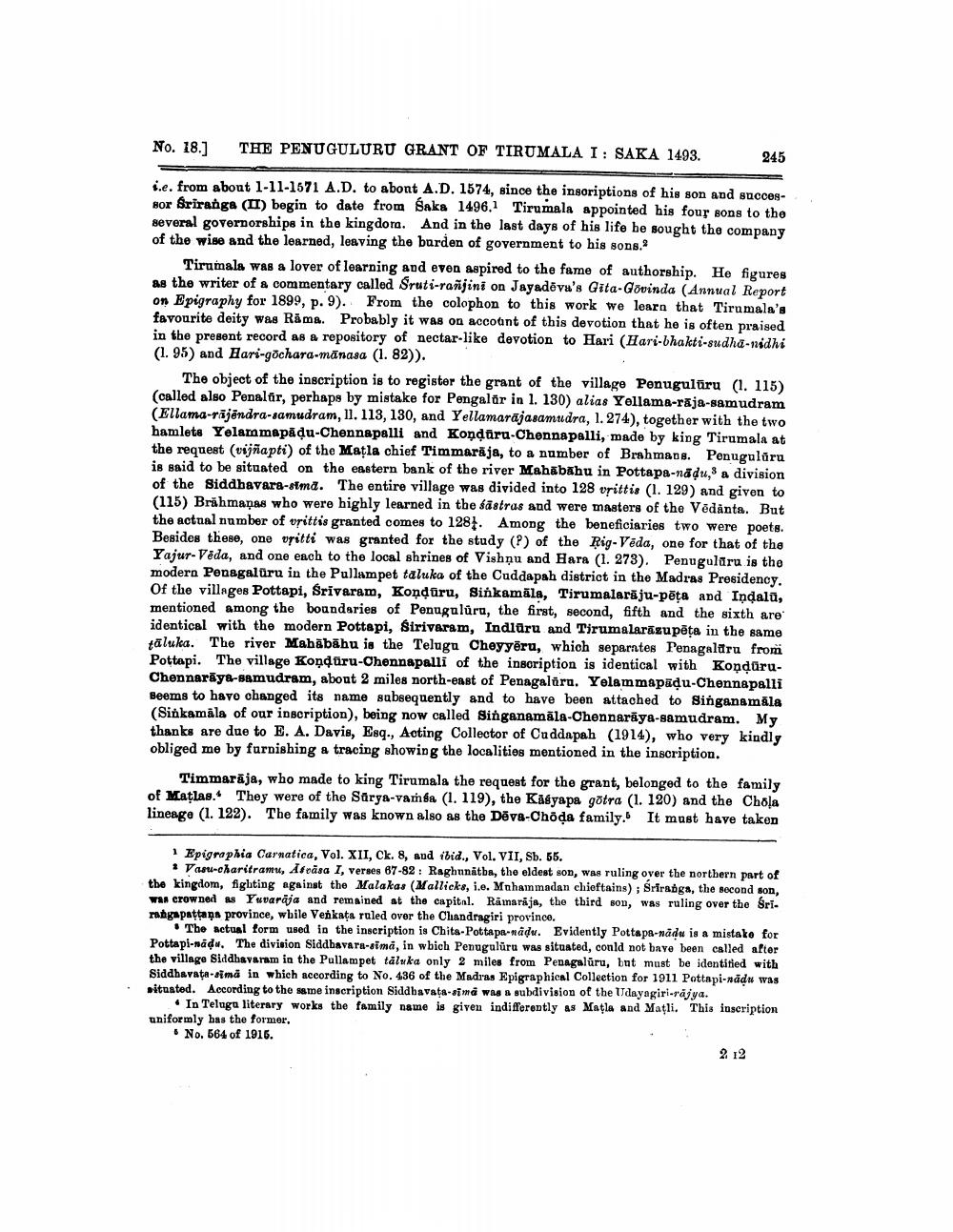________________
No. 18.]
THE PENUGULURU GRANT OF TIRUMALA I: SAKA 1493.
245
,
i.e. from about 1-11-1571 A.D. to abont A.D. 1574, since the insoriptions of his son and succes- Bor Sriranga (II) begin to date from Saka 1496.1 Tirumala appointed his four sons to the several governorships in the kingdora. And in the last days of his life be sought the company of the wise and the learned, leaving the burden of government to his sons,
Tirumala was a lover of learning and even aspired to the fame of authorship. He figures as the writer of a commentary called Sruti-rañjini on Jayadēva's Gita-Govinda (Annual Report on Epigraphy for 1899, p. 9). From the colophon to this work we learn that Tirumala's favourite deity was Råma. Probably it was on account of this devotion that he is often praised in the present record as a repository of nectar-like devotion to Hari (Hari-bhakti-sudha-nidhi (1. 95) and Hari-gochara-manasa (1. 82)).
The object of the inscription is to register the grant of the village Penugultru (1. 115) (called also Penalar, perhaps by mistake for Pengalör in 1. 130) alias Yollama-raja-samudram (Ellama-rājöndra-samudram, 11. 113, 130, and Yellamarajasamudra, 1.274), together with the two hamlets Yelammapadu-Chennapalli and Kondiru-Chennapalli, made by king Tirumala at the request (vijñapti) of the Mațla chief Timmarāja, to a number of Brahmans. Penugulóru is said to be situated on the eastern bank of the river Mahābāhu in Pottapa-nadt, a division of the Siddhavara-simd. The entire village was divided into 128 vrittis (1. 129) and given to (115) Brahmaņas who were highly learned in the sastras and were masters of the Vödänta. But the actual number of vrittis granted comes to 1284. Among the beneficiaries two were poets. Besides these, one opitti was granted for the study (?) of the Rig Veda, one for that of the Yajur Veda, and one each to the local shrines of Vishņu and Hara (1. 273). Penugolaru is the modern Penagaluru in the Pullampet taluka of the Cuddapah district in the Madras Presidency. Of the villages Pottapi, Srivaram, Konduru, Sinkamāla, Tirumalarāju-pēta and Indalū, mentioned among the boundaries of Penugalūra, the first, second, fifth and the sixth are identical with the modern Pottapi, Sirivaram, Indiðru and Tirumalarāzupēta in the same täluka. The river Mahābāhu is the Telugu Cheyyēru, which separntes Penagaldru from Pottapi. The village Konduru-Chennapalli of the inscription is identical with KondüruChennarāya-samudram, about 2 miles north-east of Penagalära. Yelammapadu-Chennapalli seems to havo changed its name subsequently and to have been attached to Singanamála (Sinkamála of our inscription), being now called Singanamāla-Chennarāya-samudram. My thanks are due to E. A. Davis, Esq., Acting Collector of Cuddapah (1914), who very kindly obliged me by furnishing a tracing showing the localities mentioned in the inscription.
Timmarāja, who made to king Tirumala the request for the grant, belonged to the family of Matias. They were of the Sarya-vamsa (1. 119), the Kágyapa götra (1. 120) and the Chola lineage (1. 122). The family was known also as the Dēve-Choda family. It must have taken
1 Epigraphia Carnatica, Vol. XII, Ck. 8, and ibid., Vol. VII, Sb. 55.
* Vasu-charitramu, Afrāsa I, verses 67-82: Raghunatba, the eldest son, was ruling over the northern part of the kingdom, fighting against the Malakas (Mallicks, i.e. Muhammadan chieftains), Sriranga, the second son, was crowned as Yuvarāja and remained at the capital. Ramarija, the third son, was ruling over the Srirangapattana province, wbile Venkata ruled over the Chandragiri province.
• The actual form used in the inscription is Chita-Pottapa-nadu. Evidently Pottapa-nadu is a mistake for Pottapi-nadu. The division Siddhavara-sima, in wbich Penuguluru was situated, conld not bave been called after the village Siddhavaram in the Pallampet tålska only 2 miles from Penagaluru, but must be identitied with Siddhavata-sim, in which according to No. 436 of the Madras Epigraphical Collection for 1911 Pottapi-nadu was situated. According to the same inscription Siddhavata-sima was a subdivision of the Udayagiri-rajya.
• In Telugu literary works the family name is given indifferently as Maţia and Matli. This inscription uniformly has the former, No. 564 of 1916.
2 12




